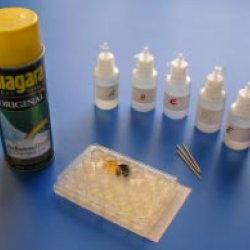Source Institutions
Source Institutions
Add to list Go to activity
Activity link broken? See if it's at the internet archive

In this challenge, learners have to figure out in what order to combine five solutions to change the color from clear, to yellow, to blue, and back to clear. The five chemicals are potassium iodide, sodium thiosulfate, sodium hypochlorite (Clorox bleach), soluble starch (Niagara spray starch), and water. The color changes indicate chemical reactions, and the lesson includes some background information about the reactions that create different colors. Suggestions are given for guiding learners through systematic approaches to making the different combinations and observing the results, and for explaining to different age groups what happens when the solutions are combined.
- 30 to 45 minutes
- 10 to 30 minutes
- Over $20 per group of students
- Ages 4 - 14
- Activity, Experiment/Lab Activity
- English
Quick Guide
Materials List (per group of students)
- 25 60-ml plastic dropping bottles labeled A, B, C, D, E
- Potassium iodide, sodium thiosulfate, sodium hypochlorite, soluble starch, water
- 5 24-well plates
- Paper towels for spills
- A container of clean water
- A safe container to dump solutions into and seal (waste container)
Subjects
-
Physical Sciences
-
Chemistry
- Chemical Reactions
- Oxidation-Reduction Reactions
- Solutions
-
Chemistry
-
The Nature of Science
-
The Scientific Process
- Conducting Investigations
-
The Scientific Process
Audience
To use this activity, learners need to:
- see
- see color
- touch
Learning styles supported:
- Involves hands-on or lab activities
Other
Components that are part of this resource:
This resource is part of:
Access Rights:
- Free access
By:
Rights:
- All rights reserved, Sciencenter,
Funding Sources:
- Camille and Henry Dreyfus Foundation, Inc.
- American Chemical Society
